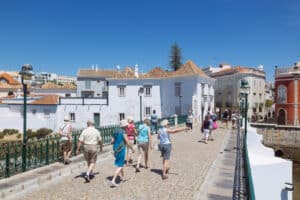With its 300 days of sunshine per year, the Algarve is a privileged region for capturing solar energy. Many people do, at least for the warming up of their water via “thermosyphon” warm water panels. For the supply of overall energy for the whole house, however, photovoltaic panels are the only way to go. We will focus on those in this article.
The ambition to become fully self-supporting “off-grid” is understandable, and where no grid connection is available, that is obviously even necessary. However, keeping a grid-connection as a backup for peak demands remains the best cost-benefit option.
Illustrating this: Modern panels produce around 400 Watts each. So, feeding a 2000 W hairdryer alone requires five of them. However, using that hairdryer during five minutes per day, that adds up to 2.5 kilowatt-hours in a month. At an average price of €0.20 a “kwh”, that represents only €0.50. On the other hand, a refrigerator with its only 30 Watts works 24/7 and, therefore, consumes 22 kwh a month, costing €4.40.
By using such simple calculations, one can easily see what the “big spenders” are. Such exercise is interesting for a number of reasons. First of all, one may control if the bills remain in line with consumption. Secondly, one may verify the options for savings with better management, or the costs to be expected upon buying new appliances. And last but not least, it is interesting to see what is spent even when you are not around, such as an automatic irrigation system.
Likewise, it is interesting to compare night and day consumption, to see if an eventual investment in batteries would pay off. Systems that keep such option open for a later decision also exist.
A lot of information can already be found on the bills, even if they sometimes are a bit tricky to understand. How much energy is spent on what part of the day is specified as “Ponta”, “Vazio” and “Cheia”, whereas the option to pay a flat-rate or a differentiated one is specified as “Simples” or “Bi-horário” or even “Tri-horário”.
Another important detail on the bill is the power contracted, see the amount of kVA under “Potência”. Usually this is the maximum power approved for the house, being also the maximum one may generate with solar panels, for obvious safety reasons.
All of the above jointly indicates the ideal type and capacity of a PV-system.
When that is determined, the next step is to see if the subsequent number of panels can be placed, and where.

Panels can be placed on the ground, on the roof, or on a carport, but have to face as much southwards as possible, or be in a combined east-west configuration. More important is that they are free of shade.
Solar panels produce direct current, or “DC”. This needs to be changed to alternating current “AC” for the house, which is done by a so-called inverter. Some systems have small “micro-inverters” on the back of each panel set. These are placed parallel to each other and directly feed AC to the house.
Other systems have panels in series, so-called “strings”, feeding one large inverter that usually sits inside the house.
The first option has the advantage that shading on one panel does not hamper the others. But a big disadvantage is the placement of sensitive electronics on a roof, where it can easily suffer damage.
Furthermore, these systems will automatically inject surplus energy into the grid. And that requires a bi-directional meter to be supplied by the grid supplier.
The second system has several advantages above the first. It is more efficient, and it has no sensitive electronics exposed outdoors. Apart from that, centralised inverters usually offer more management and monitor options.
Mentioned inverter should ideally sit in the house or garage or even in a special box, but always in a moist-free and ventilated space. The same applies for eventual batteries.
Cabling is another issue. Between the panels and the inverter, heavy DC cables must run in an exclusive, not shared, conduit. When going through the ground, they should be placed in a special trench. When coming down from the roof or a carport, they must be protected in adequate housing.
From the inverter to the main switchboard goes another heavy cable, being an AC one. And finally, a thin internet cable should be connected between the smart-meter and the router. All of that cabling can obviously better be planned before finishing a building or remodelling job than afterwards.
Selling surplus energy to the grid is an option, but bluntly put, for individual households, the current prices do not justify the bureaucracy. Maybe this will change in the future if the grid infrastructure becomes stronger, and if energy companies find better ways to store energy.
When that happens, most PV systems may be easily adapted.
Always forgotten in ROI equations is the rise in real estate value.
All PV-systems in Portugal need to be inspected and certified. Serious PV-system suppliers take care of this for their customers.
Honest advice and sober ears bring the best results.
By Hans Mulder
Hans is a Dutch citizen who helps a local supplier of PV-systems to answer information requests and doubts from Algarve residents. He welcomes your e-mail. hansmuldernow@gmail.com




















